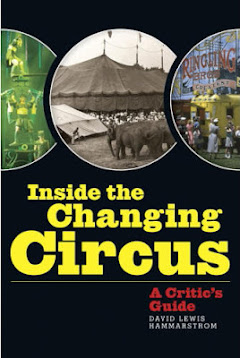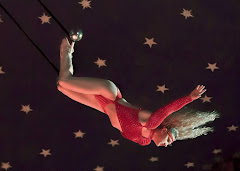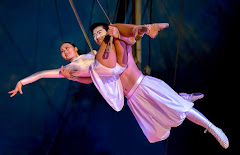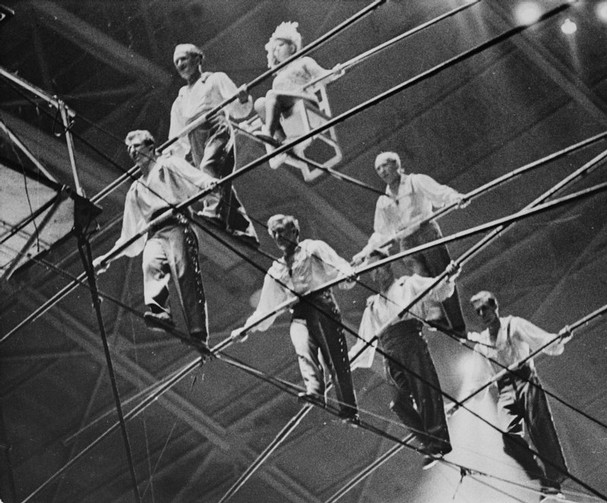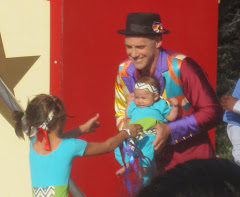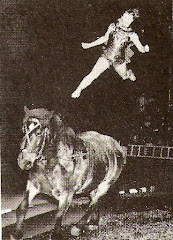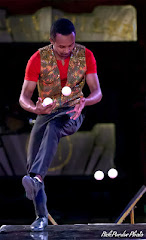Book Review:
The Circus: 1870-1950
Noel Daniel, editor
Dominique Jando, Linda Granfield, and Fred Dahlinger,Jr., contributing writers.
It is so huge and handsome and heavy, so perfectly put together, it will immediately impress you with its sheer grandeur. You will be swept away by the scope and brilliance of its reproductions, many of them rare discoveries that bring back to life the greatness of — yes, mostly Ringling Bros. and Barnum & Bailey Circus under the big top. By that measure alone, there is no other book on the planet I can think of that comes close to this one.
And after a while, you may begin to tire of the arduous journey, as the turning of pages becomes more of an effort and you wonder if you have the will and the muscle to make it on through to the end. You might wonder if too much has been stuffed into the tent. At 670 pages containing some 900 illustrations, The Circus is not a book. This is a 20 pound (I kid you not) museum in your lap. You might get a friend to turn the pages and balance the thing while you, free of a workout, gawk and thrill to the American circus when it was the American circus. The authors are obviously smitten of how we took a one ring darling and turned it into a three-ring spectacular.
Let me make clear the limitations of this review: Yesterday at the San Francisco Public Library where I finally got my hands on a copy, I did not read this book, anywhere near, and I have little desire to. It is not designed to bring out the reader in anybody. I only read bits and pieces, and my impression (I stress impression) is that most of the text is generic. As for the assertion of some, PC-driven, that it offers revisionist history concerning, among other matters, women in the circus, this issue is hardly new, and it has been responsibly covered in other contemporary books.
The Circus directed my attention, page after page, to its captivating photographs. And I felt a sense of euphoria, becoming a circus fan all over again as I wandered through the multitude of epic imagery, against which the earnestly serviceable words that comprise the mini-chapters and captions are like dust in the Roman Coliseum. Many of the black and whites will be familiar to circus fans, I have used some of them in my own books. However, the color reproductions deliver treasures I have never before seen. And that alone makes this bookeum (yes, I just made up a word; it was necessary) a stunning triumph.
For my personal taste (call me biased), Miles White and the man who hired and charmed the best work out of him, John Ringling North, are the stars. And why there are no photos of them, or of any of the other movers and shakers who created these spangled holidays, is a puzzlement. How to count the delights? Photos of performers costumed for one production number after another —parades I never saw — left me left me limp with joy. White’s stupendous creativity is simply unmatchable. Other backyard scenes in color mesmerize. Ballet of the Elephants dancers, all in pink, exiting the big top, whose sidewalls that year were red, with air conditioning wagons nearby. Performers between shows relaxing under the guy lines in lawn chairs along a row of stairwells leading to the private dressing rooms at the ends of the seat wagons.
You are there next to lovely Pinito Del Oro, there next to a young Francis Brunn. There next to a couple of black canvas guys checking out the bale ring around a center pole, only a few feet off the ground. You can almost feel the show going up. There's Lou Jacobs with his Hindenburg-sized cigar, and a young shirtless, anatomically perfect Pete Cristiani, fit for GQ Magazine. A gigantic foldout reproduces a Ringling Bros. 1898 litho featuring a "ladies orchestral symphony" in the center of a menagerie!
And then you may reach a point of numbing overkill. This editor simply could not stop. This Noel Daniel has produced a monster, compared to which, the Parkinson-Fox tome The Circus in America seems petite. There are visual redundancies that border on filler. Certain types of acts or certain artists are over represented. There is no clear narrative at work here, the chapters vaguely delineated one from the other. For example, two different chapters both focus on aerial and/or daredevil acts.
The title? A clear tip-off that Daniel has little interest in a book with a theme and a direction. Really, what is this tome about other than about showing off its massive acquisition of photography and poster art? The text? I wonder, will anybody read it? The essays are far from in-depth (Granfield might have told us why and how one ring became three), the photo captions not much more than functional, and even they sometimes lack specifics. Which is a surprise given the trio of touted expert "scholars" who worked together on this massive project. I guess even a committee can make mistakes.
The book is not error free. I paused now and then to read captions for photos that caught my fancy, I stumbled upon a few errors. Takeo Usui “wire dancing”? He worked an inclined wire, executing forward and backward slides. We learn on one page that the title "The Greatest Show on Earth" was first used by P.T. Barnum in 1872; on another page, in 1873. I thought the slogan emerged a few years later, but I could be wrong. A 1947 photo of an elephant and a woman, the woman identified as a “fan,” looked to me like Betty Hutton, which would place the photo closer to 1951. A 1952 aerial ballet photo mentions 60 women aloft; most will tell you that North never employed more than 48.
Does it matter? Evidently, not to Daniel. If text mattered, why does some of it appear on color backgrounds? And why in three languages? The cumbersome and bulky layout taxes one's patience and resolve. Indeed, trying to read this glorious hodgepodge feels like trying to read a Times Square theatre flyer through a blinding flash of neon lights. The title is carelessly misleading. 1950 really should have been 1956, for that is when the great American circus came to an end — in Pittsburgh. And why 1870? The coverage extends back to Circus Maximus days and before, perhaps back to the Garden of Eden, I did not get that far into the chapter.
But, oh, the photos! Simply to die for. Some of these images are revelations. A dancer ready to go on in Ringling’s 1956 elephant bash, “Ringling Rock N' Roll,” reveals the brilliance of a Vertes costume design, and the savvy of North in hiring him. Sadly, it was the wrong season. The same season delivered perhaps the shabbiest spec ever, a parade entitled "Say it with Flowers" that ended up looking more like "Say it with Cement." Photos of that misfire would have helped bring this book to a more dramatic and historically accurate conclusion. But, in the end, we are back where we began, back gawking at thrill acts under mammoth tents attended by thousands of enthralled spectators. Back in a wonderland of hoopla, courage and beauty that bursts vividly through in these magnificent illustrations. Words not needed.
Monday, February 23, 2009
Friday, February 20, 2009
Friday Night L’Amyxery: Atlanta Hosts Four Major Circuses This Weekend ...Who Said That Big Tops Are Dying? ...
If you've got the money and the time, get thee to Atlanta NOW. Today thru Sunday, arguably the best four circus companies that tour the states are ALL in town. I’m talking Cirque du Soleil’s Kooza, highly recommended; Big Apple's Play On! , Ringling’s Over the Top and UniverSoul's Jabulani. In what other city on the planet can one see such an abundance of top-drawer sawdust talent in the space of a few days? I’m envious, Atlanta! Thank you, Don Covington, for linking the story my way ...
Ringling’s latest opus, Zing, Zang Zoom, looks visually dazzling on a You Tube teaser; check it out over at Sawdust Nights, whose Logan Jacot, missing in action, is back in action and posting aplenty. He hosts solid news items and fabulous videos ... Where oh Where are there reviews for Zing? I’ve searched the web and find none. One lone comment jumped out at me from the website Yelp! — a woman who was amply entertained but also left madly aghast by the concession prices: “BEWARE! Cotton candy for 12.00 What!!!!! Lemon aid $9.00 are your freakin’ kidding me, what are they thinking? For sure people would be willing to spend their hard earned money in events like this if prices were reasonable. $12.00 for cotton candy is ridiculous!!!!! That’s $36.00 if you have 3 kids.”
Moral of story? Don’t have more than one kid, either that or go to work for Kenneth Feld and you might get a special employee discount. Or maybe you could advance to cotton candy producer and have all you want, free ...
End ringers: PR man Jerry Digney , whose previous clients include Irvin Feld and Cliff Vargas, in agreement with my high acclaim for those captivating Flying Espanas: "... a fantastic act and they were amazing showman. A beautiful act." Jerry: I checked my old Vargas programs, and they did, indeed, fly high for Vargas in 1985, divided up into two troupes for the end rings while the Rodogels commanded the center ring, likely as I recall because they threw the triple. Not so, as I recall, the otherwise showmanly Ramon Espana... Another Digney delight: the photo I posted of John Ringling North, 1949, with phone in the back seat of his private limousine. “I loved the shot ... they had car phones then?” Evidently so. Digney remembers running into North the Original at Monte Carlo, there to judge for the Prince, and being chauffeured about, same royal style, in a Mercedes ...
Out of the Past: From the Bandwagon’s reprint of the New York Clipper’s man on the lot traveling with Ringling-Barnum, 1925: Merle Evans, ever aware of pop trends, would try out new tunes on ex-side show manager and ringmaster, Lou Graham. The Maestro in Springfield played a pair for possible inclusion in the score. “One got the quick approval of the announcer” The other, a waltz titled “Forget Me Darling,” did not fare as well. “Graham made a grimace of dislike and observed crisply, ‘Good advice to take.”
... My heart goes out to the Aussies in the wake of the horrific fires. From Barry Nixon, “Personally, I am okay, but thousands in my district affected. Death toll will reach 300, homes lost now greater than 2,000 ...” Nixon tells me of Aussie circuses, along with stage companies and sports teams, staging benefit shows. “Aussie spirit is good!”
Now, that’s a high hopeful note to end on ....
Ringling’s latest opus, Zing, Zang Zoom, looks visually dazzling on a You Tube teaser; check it out over at Sawdust Nights, whose Logan Jacot, missing in action, is back in action and posting aplenty. He hosts solid news items and fabulous videos ... Where oh Where are there reviews for Zing? I’ve searched the web and find none. One lone comment jumped out at me from the website Yelp! — a woman who was amply entertained but also left madly aghast by the concession prices: “BEWARE! Cotton candy for 12.00 What!!!!! Lemon aid $9.00 are your freakin’ kidding me, what are they thinking? For sure people would be willing to spend their hard earned money in events like this if prices were reasonable. $12.00 for cotton candy is ridiculous!!!!! That’s $36.00 if you have 3 kids.”
Moral of story? Don’t have more than one kid, either that or go to work for Kenneth Feld and you might get a special employee discount. Or maybe you could advance to cotton candy producer and have all you want, free ...
End ringers: PR man Jerry Digney , whose previous clients include Irvin Feld and Cliff Vargas, in agreement with my high acclaim for those captivating Flying Espanas: "... a fantastic act and they were amazing showman. A beautiful act." Jerry: I checked my old Vargas programs, and they did, indeed, fly high for Vargas in 1985, divided up into two troupes for the end rings while the Rodogels commanded the center ring, likely as I recall because they threw the triple. Not so, as I recall, the otherwise showmanly Ramon Espana... Another Digney delight: the photo I posted of John Ringling North, 1949, with phone in the back seat of his private limousine. “I loved the shot ... they had car phones then?” Evidently so. Digney remembers running into North the Original at Monte Carlo, there to judge for the Prince, and being chauffeured about, same royal style, in a Mercedes ...
Out of the Past: From the Bandwagon’s reprint of the New York Clipper’s man on the lot traveling with Ringling-Barnum, 1925: Merle Evans, ever aware of pop trends, would try out new tunes on ex-side show manager and ringmaster, Lou Graham. The Maestro in Springfield played a pair for possible inclusion in the score. “One got the quick approval of the announcer” The other, a waltz titled “Forget Me Darling,” did not fare as well. “Graham made a grimace of dislike and observed crisply, ‘Good advice to take.”
... My heart goes out to the Aussies in the wake of the horrific fires. From Barry Nixon, “Personally, I am okay, but thousands in my district affected. Death toll will reach 300, homes lost now greater than 2,000 ...” Nixon tells me of Aussie circuses, along with stage companies and sports teams, staging benefit shows. “Aussie spirit is good!”
Now, that’s a high hopeful note to end on ....
Monday, February 16, 2009
Reviving Broadway: Pal Joey Flops; South Pacific Sails On: Will the Rodgers and Hammerstein Organization Ever Learn?

The triumphant revival of South Pacific, which closely follows the original 1949 script, is nearing the end of its hugely successful first year at Lincoln Center.
Meanwhile, in the land of make-believe makeovers, the recent revival of yet another rewritten Pal Joey stumbles prematurely towards an early closing at Studio 54. It will have lasted less than three months.
The Rodgers and Hammerstein Organization, it appears, refuses ever to learn from its many failed attempts to rewrite the shows that charmed the critics and public when they first opened --- to rewrite them into more sophisticated treatments aimed at pandering to modern audiences.
The late Richard Rodgers once wrote, “We’ve found from experience, some of it painful, that the best way to project these things and to get a response from a live audience is to do them the way they were done originally, after we got finished correcting them ourselves.”
This latest effort to breathe new life into Pal Joey in the form of a revised book by Richard Greenberg, met with generally downbeat reviews. Ben Brantley in The New York Times called it, among other things, “joyless.”
Was it the fault of yet another dubious libretto overhaul? Or, had it adhered faithfully to John O'Hara's original script, might Joey still have fizzled? Some of the critics pounced hard on the direction and certain cast members.
 R&H seem never to have realized that revivals, no matter how good, usually have a much shorter life on the boards the second and third times around. For example, A Chorus Line, played 15 years when first produced; recently in its first return to Broadway, it lasted not quote two years. One aberrational exception to this general reality is Chicago, which enjoyed a modest 2 year run when first staged, but has turned itself into a revival phenomenon -- over 12 years and still a survivor on the Great White Way!
R&H seem never to have realized that revivals, no matter how good, usually have a much shorter life on the boards the second and third times around. For example, A Chorus Line, played 15 years when first produced; recently in its first return to Broadway, it lasted not quote two years. One aberrational exception to this general reality is Chicago, which enjoyed a modest 2 year run when first staged, but has turned itself into a revival phenomenon -- over 12 years and still a survivor on the Great White Way! I believe that R&H have an artistic (one could argue moral) obligation to respect these ground-breaking musicals and the gifted artists who created them in the first place, and to let audiences enjoy them, as Richard Rodgers said, "the way they were done originally."
After months of playing to full houses, South Pacific’s box office may be slipping a bit. I suspect that once serious New York theatregoers have their chance to enjoy this fabulous production, it’s ticket sales will naturally wane, and that it can’t count on tourists to fill up the seats. It’s an old fashioned love story that is not going to have widespread appeal to the younger generations who flock to see shows like Wicked and Hairspray.
Ironically, Pal Joey is the cynical musical — the one whose amoral pulse (gigolo uses rich woman to open night club) you’d think might make it a hot sell. Evidently, Greenberg's script, or the direction, has somehow managed to make the play even “seamier,” according to one critic, while making the show itself far less engaging.
And that’s not entertainment.
[photos, above: Matthew Morrison and Li Jun Li in the current revival of South Pacific; Gene Kelly in the original 1940 production of Pal Joey]
Saturday, February 14, 2009
Under Big Top Blogs, Beware the Minefields of Hidden Agendas, Veiled Work Offers, Get-Even Comments, Hype and Hope and Hypocrisy ...
Post Post Update, Sunday, 12:30 PM: I encourage you to read the
comments, very diversified and offering a number of takes on the
concession pitching issue you may find of great value. And thank you,
Steven, for your nice message to me on your blog.
It's a swampland of half-truths and spin, of misinformation and veiled get-even messages out there when you try navigating your way through circus blogs. What is so interesting is that most of them are hosted by inside professionals, and they no doubt harbor all sorts of hidden agendas. Sometimes I feel like an innocent in the middle of it all, watching comments fly this way and that and wondering who has a grudge to bear or a friend to puff. Spurned? Fired? Told your act is over the hill?
But, how else to get information. The White Tops? Circus Report? In this country, aside from the old Billboard that once tried to impart objective news, we have had to rely on fans and press agents. Good luck.
Jim Royal, who manages Kelly Miller Circus, has commented to me about the problem he has with bloggers who pass along rumors he feels compelled to quell. How ironic that Kelly Miller, at least since John Ringling North II purchased the show, seems to attract to its staff bloggers who just can’t stop blogging — about Kelly Miller.
Last season we were feted for a time by media relations man Ben Trumble’s almost daily accounts of business, much of it not good, and of his second guessing the advance. The same Trumble who now, before even seeing the new Kelly Miller show, will declare it practically the greatest tent show since, well, what was the last show that Trumble trumbled for? One day soon, circus owners may stipulate in contracts what bloggers who work for them may and may not say.
Where’s the laughter, there’s truth? Now comes, for the 2009 tour, a new touring-with-it blog of Steven Copeland, who is clowning this year on Kelly Miller with his partner, Ryan Combs. His detailed postings promise a daily dose of rich insider information, which is why I believe it could become the hit blog of the season. So far, two days into the tour, we learn of packed and turnaway houses. (What say ye to that, Mr. Trumble?) When the crowds don’t come, will Copeland complain? When nasty arguments suddenly break out in the backward, will delicious dirty laundry make it into Copeland's daily open-book diary?
I too am the victim of misinformation that I stunmble onto when now and then touring the blogs, such that I have become very leery. One of them, for example, gave me a solid impression that Copeland and Combs were in a relationship of the kind that is now legal in Massachussets. The information was delivered in a warm celebratory air. So, when about to mention their names in connection with a Kelly Miller story, I gave a lot of respectful thought to how I might identify the two. I decided on the term “life domestic partners.” How royally wrong I was.
Within an hour or so of my posting going up and the multitudes rushing on line to read it (well, all three of you out there), came a stinging rebuttal complete with lecture on proper research etiquette from Steve, informing me in an e-mail that “We are friends and we work together, but that is it.” Moreover, added he tersely, “Please check your sources before you post things in the future.”
Now either Steve, while working for media master Kenneth Feld, picked up a tip or two on how to manipulate a writer, or the source from which I derived my information is itself full of buffonic baloney. I sent Steve and apology, disclosing the source, immediately deleted it from my own posting (thus nullifying a marriage that never was), and returned to re-check the source, feeling like a careless kid whose hand had just been slaped. How could I get something like this so so wrong?
How? By simply spending some fun time a while back inside Pat Cashin’s well regarded (I assume) Clown Alley. After finding not just one but two postings alluding to a full-scale relationship between the two partners, I e-mailed Steve, suggesting that since he is so bothered by the false impression lent, that he make the same remove-it request to Pat that he made to me. So far, those two postings remain.
Perhaps there is a double standard at work, or maybe I’m clueless on some inside joke. Wrote Steve to Showbiz David, “No hard feelings. Pat is always kidding us, I figured at some point that comment would be misconstrued.”
That “comment”??? There are two postings replete with many comments, and by others too, all of them in a very upbeat mode.
Under these bloggy big tops, the rules change from performance to performance.
I wish friends Copeland and Combs no harm, only luck on the tour ahead. And I cry for these clowns, having learned to my alarm that they too, are pitching coloring books, which I regard as a supreme insult to any self-respecting artist. John Ringling North II: Is this the sort of a circus owner he intends to be? What a devastating clue to his showmanship. To be a real Ringling, he has yet a far distance to travel.
I’m going back to Pat's Clown Alley for a little inspirational relief from the Dali Lama. But, please, don’t tell me that he too is now flacking for Peterson Peanuts.
First posed February 14, 2009
It's a swampland of half-truths and spin, of misinformation and veiled get-even messages out there when you try navigating your way through circus blogs. What is so interesting is that most of them are hosted by inside professionals, and they no doubt harbor all sorts of hidden agendas. Sometimes I feel like an innocent in the middle of it all, watching comments fly this way and that and wondering who has a grudge to bear or a friend to puff. Spurned? Fired? Told your act is over the hill?
But, how else to get information. The White Tops? Circus Report? In this country, aside from the old Billboard that once tried to impart objective news, we have had to rely on fans and press agents. Good luck.
Jim Royal, who manages Kelly Miller Circus, has commented to me about the problem he has with bloggers who pass along rumors he feels compelled to quell. How ironic that Kelly Miller, at least since John Ringling North II purchased the show, seems to attract to its staff bloggers who just can’t stop blogging — about Kelly Miller.
Last season we were feted for a time by media relations man Ben Trumble’s almost daily accounts of business, much of it not good, and of his second guessing the advance. The same Trumble who now, before even seeing the new Kelly Miller show, will declare it practically the greatest tent show since, well, what was the last show that Trumble trumbled for? One day soon, circus owners may stipulate in contracts what bloggers who work for them may and may not say.
Where’s the laughter, there’s truth? Now comes, for the 2009 tour, a new touring-with-it blog of Steven Copeland, who is clowning this year on Kelly Miller with his partner, Ryan Combs. His detailed postings promise a daily dose of rich insider information, which is why I believe it could become the hit blog of the season. So far, two days into the tour, we learn of packed and turnaway houses. (What say ye to that, Mr. Trumble?) When the crowds don’t come, will Copeland complain? When nasty arguments suddenly break out in the backward, will delicious dirty laundry make it into Copeland's daily open-book diary?
I too am the victim of misinformation that I stunmble onto when now and then touring the blogs, such that I have become very leery. One of them, for example, gave me a solid impression that Copeland and Combs were in a relationship of the kind that is now legal in Massachussets. The information was delivered in a warm celebratory air. So, when about to mention their names in connection with a Kelly Miller story, I gave a lot of respectful thought to how I might identify the two. I decided on the term “life domestic partners.” How royally wrong I was.
Within an hour or so of my posting going up and the multitudes rushing on line to read it (well, all three of you out there), came a stinging rebuttal complete with lecture on proper research etiquette from Steve, informing me in an e-mail that “We are friends and we work together, but that is it.” Moreover, added he tersely, “Please check your sources before you post things in the future.”
Now either Steve, while working for media master Kenneth Feld, picked up a tip or two on how to manipulate a writer, or the source from which I derived my information is itself full of buffonic baloney. I sent Steve and apology, disclosing the source, immediately deleted it from my own posting (thus nullifying a marriage that never was), and returned to re-check the source, feeling like a careless kid whose hand had just been slaped. How could I get something like this so so wrong?
How? By simply spending some fun time a while back inside Pat Cashin’s well regarded (I assume) Clown Alley. After finding not just one but two postings alluding to a full-scale relationship between the two partners, I e-mailed Steve, suggesting that since he is so bothered by the false impression lent, that he make the same remove-it request to Pat that he made to me. So far, those two postings remain.
Perhaps there is a double standard at work, or maybe I’m clueless on some inside joke. Wrote Steve to Showbiz David, “No hard feelings. Pat is always kidding us, I figured at some point that comment would be misconstrued.”
That “comment”??? There are two postings replete with many comments, and by others too, all of them in a very upbeat mode.
Under these bloggy big tops, the rules change from performance to performance.
I wish friends Copeland and Combs no harm, only luck on the tour ahead. And I cry for these clowns, having learned to my alarm that they too, are pitching coloring books, which I regard as a supreme insult to any self-respecting artist. John Ringling North II: Is this the sort of a circus owner he intends to be? What a devastating clue to his showmanship. To be a real Ringling, he has yet a far distance to travel.
I’m going back to Pat's Clown Alley for a little inspirational relief from the Dali Lama. But, please, don’t tell me that he too is now flacking for Peterson Peanuts.
First posed February 14, 2009
Wednesday, February 11, 2009
Kelly-Miller Bolts to Texas for Early Opening ... John Ringling North II on the Lot Supervising Rehearsals ... Judkins Promoting Lone Star Dates ...
In a dramatic departure from its ordinary Hugo, Oklahoma March opening, Kelly-Miler Circus jumped 700 miles this week into Brownsville, Texas, where its “official” 2009 tour begins tomorrow, Thursday, for a four-day, 10 show frame.
Move was made partly to avoid expense-draining sits in Hugo and add early revenue into the coffers. Last season, total fuel bills were "up over" $100,000.00 from the previous tour, and the profit margin is slim, according to show manager James Royal in an e-mail to Showbiz David.
Circus owner John Ringling North II okayed a plan by Jim Judkins to book the early Texas dates which Judkins' shuttered Circus Chimera used to play. Judkins "knows the ‘valley’ well and we decided to have a joint venture there,” says Royal. “As you know, while in winter quarters it is all cash flowing in the wrong direction.”
North was on the lot in Brownsville, actively engaged in production meetings and rehearsals, monitoring his third-season show as it takes shape under the general direction of ringmaster and performance director John Moss.
North’s engaging enthusiasm has been something of a surprise to staff members ever since he bought the Kelly-Miller title back in 2006. Nephew of famed circus owner and producer John Ringling North, the younger North brings authentic Ringling blood back to a tent circus at a time when American shows are struggling to stay solvent over sawdust and find new ways to reinvigorate public patronage.
At one run-through that had North's creative attention, clowns Steven Copeland and Ryan Combs, booked to handle comedy chores, were asked by the boss to spot their chase pants routine while a tiger is chasing an explorer who is chasing his pants. “It is going to be very wacky!” blogged Steven.
The world of the internet promises to continue following this show in possibly day-to-day detail, which is potentially good news for fans. Steven and Ryan have up and running a diary-like account of their day to day activities on the circus. (www.steveandryan.blogspot.com). It well could become the hit big top blog of the season.
Kelly-Miller is offering this year what Ben Trumble, high on the individual performers, calls "classic circus." Trumble was in Hugo taking a look at all of its shows getting ready to hit the trails soon. North has tigers and elephants, a big group horse-ridding act (a rarity in today's market), fliers and jugglers. Music is produced electronically (act CDs pre-loaded), with live drumming enhancements added by an old college buddie of North's, Lucky. One of the most delicious rumors out of Hugo has it that a new production number is “out of The Greatest Show on Earth” (The film). One act awaiting visa clearance, and another felled by an injury, has made necessary temporary performer substitutions, according to Royal, whose pickup truck was on the fritz as of late last night, holding him back in Hugo.
A source in Hugo reported that some of the riders originally signed to work in Armando Loyal's horse number did not pan out, and so others had to be recruited at the last minute and may need the extra Texas time to perfect their equestrianship.
Kelly Miller will head back to Hugo for a March 28 date. The show is slated to pitch canvas in Milwaukee, prior to the resumption of the circus parade in July.
Added Royal in his e-mail, “John and I have strived to create a show where ALL members of the company feel valued and appreciated."
They might also feel part of a most interesting, potentially exciting Ringling story unfolding.
Move was made partly to avoid expense-draining sits in Hugo and add early revenue into the coffers. Last season, total fuel bills were "up over" $100,000.00 from the previous tour, and the profit margin is slim, according to show manager James Royal in an e-mail to Showbiz David.
Circus owner John Ringling North II okayed a plan by Jim Judkins to book the early Texas dates which Judkins' shuttered Circus Chimera used to play. Judkins "knows the ‘valley’ well and we decided to have a joint venture there,” says Royal. “As you know, while in winter quarters it is all cash flowing in the wrong direction.”
North was on the lot in Brownsville, actively engaged in production meetings and rehearsals, monitoring his third-season show as it takes shape under the general direction of ringmaster and performance director John Moss.
North’s engaging enthusiasm has been something of a surprise to staff members ever since he bought the Kelly-Miller title back in 2006. Nephew of famed circus owner and producer John Ringling North, the younger North brings authentic Ringling blood back to a tent circus at a time when American shows are struggling to stay solvent over sawdust and find new ways to reinvigorate public patronage.
At one run-through that had North's creative attention, clowns Steven Copeland and Ryan Combs, booked to handle comedy chores, were asked by the boss to spot their chase pants routine while a tiger is chasing an explorer who is chasing his pants. “It is going to be very wacky!” blogged Steven.
The world of the internet promises to continue following this show in possibly day-to-day detail, which is potentially good news for fans. Steven and Ryan have up and running a diary-like account of their day to day activities on the circus. (www.steveandryan.blogspot.com). It well could become the hit big top blog of the season.
Kelly-Miller is offering this year what Ben Trumble, high on the individual performers, calls "classic circus." Trumble was in Hugo taking a look at all of its shows getting ready to hit the trails soon. North has tigers and elephants, a big group horse-ridding act (a rarity in today's market), fliers and jugglers. Music is produced electronically (act CDs pre-loaded), with live drumming enhancements added by an old college buddie of North's, Lucky. One of the most delicious rumors out of Hugo has it that a new production number is “out of The Greatest Show on Earth” (The film). One act awaiting visa clearance, and another felled by an injury, has made necessary temporary performer substitutions, according to Royal, whose pickup truck was on the fritz as of late last night, holding him back in Hugo.
A source in Hugo reported that some of the riders originally signed to work in Armando Loyal's horse number did not pan out, and so others had to be recruited at the last minute and may need the extra Texas time to perfect their equestrianship.
Kelly Miller will head back to Hugo for a March 28 date. The show is slated to pitch canvas in Milwaukee, prior to the resumption of the circus parade in July.
Added Royal in his e-mail, “John and I have strived to create a show where ALL members of the company feel valued and appreciated."
They might also feel part of a most interesting, potentially exciting Ringling story unfolding.
Saturday, February 07, 2009
New Musical in L.A.: Minsky's -- Can Song-and-Dance-Terrific Tuner Dazzle Its Way Out of a Lame Book?
 New Musical Review
New Musical ReviewMinsky’s, at the Ahmanson Theatre
Media Update, 2/9. The show opened to generally tepid reviews -- so far. Surprisingly, The New York Times sent Charles Isherwood out to review the opening; he filed a kindly skeptical notice for its New York prospects. A dismissive review in the Los Angeles Times borders on a pan. A few blog sites are expressing keen enthusiasm.
LOS ANGELES, January 22 – Watching the powerhouse production numbers in this promising new tuner that lift it to Broadway heights, is much like watching an old movie musical whose songs and dances soar as high as its tediously silly dialogue scenes sink, leaving you waiting for the real stuff to resume. During the waits, to be sure, there is a fair amount of miscellaneous shtick, jokes and gags, some of which keep a sporadically plodding book from going under. What might it take to turn this promising vaudeville romp into a viable Broadway success? In its current condition, witnessed during the second night of previews, Minsky’s is in need of a major script overall. (According to program notes, the libretto is said to be an original.)
At the center of the musical’s “conflict” is self-serving city politician, Randolph Sumner (George Wendt), seizing an issue likely to be found in a risque troupe of Burlesque entertainers: They’ve got to be raided and shut down. The troupers are directed and goaded on with 42nd Street crackle by one Billy Minsky, played by actor Christopher Fitzgerald in a Robert Morse vein. Enter a not very convincing love interest when Summer’s uppity do-good daughter, Mary, essayed a little too wobbly here by Kathrine Leonard, accidentally meets the Minsky man. She comes across as a Woody Allen scripted Mia Farrow in the key of psycho-nerdy. The two share some pleasant though too pleasantly passive duets, and therein lies the problem. Minsky, fearing his new heartthrob will find out who he actually is, gets a staff member (the hilariously droll Boris, executed to perfection by Paul Vogt) to assume his identity. But this whole character identity thing is more belabored than engaging. Another disguise has Sumner going in drag so he can invade the cast. Rather than magnify the dramatic tension to match those sky-high dance workouts staged by director-choreographer Casey Nicholaw, these threadbare plot contrivances trivialize it into a meandering smorgasbord.
At the top of the credits should go the team of Strouse and Berkenfield (that would be 80-year-old vet tunesmith Charles Strouse and Susan Berkenhead). These two, in lush collaboration, have delivered a sassy and relevant, rarely flagging slate of old-line show tunes. Only could their output include one or two more modern-styled ballads. Here is a score that older theatre buffs will tap their toes to; the younger set may find it, straddled to all the corny scripting shenanigans, a tad musty and yawnfull.
Fifty years ago on the Great White Way, the Minsky's that opened at the Ahmanson Theatre (the show was originally slated to go on the boards 10 years ago) might have done the trick with its gaudy bawdy gags and crackerjack songs. As it is, it’s a doubtful prospect without more savvy development. That may come, for all we know.
Show is loaded with Broadway-ready talent, all except for Leonard (or the character she must play). Christopher Fitzergerld gets the role right on, although he or the role tends to wear thin and one-sided into the second half; slyly amusing John Cariani produces, in tandem with Rachel Dratch, the score’s most memorably inventive gem, the anti-musical “I Want a Life.” Kevin Cahoon as piano tunesmith Buster is perfectly charming, and Beth Leavel (Maisie) is a Mermanesque asset. They've got songs to sing, they do, and these deliciously crafted numbers bear attractive shades of Kander and Ebb, Jerry Herman (in the truly thrilling “Nothing Lasts Forever”) and even a touch of Sondheim (“Home”) Only two tunes seem a little too modest for the rush of high-energy scoring — “Keep It Clean” and what feels like an obligatory romantic ditty, “Eyes Like that.” It’s the sort of a score that would make a good CD for those of a certain age.
Because of the disparity between the production dynamics and a plodding book, the show jerks and creeks in spots, and a few items are outright side-bar gratuitous, stopping a potential momentum cold in its tracks. Indeed, it seems as if the team felt obligated to honor a standard book it don’t really believe in. Were Minksy's to be told in a revue format, with one character (say, the Jimmy Durante-ish Gerry Vichi, a perpetually welcome clown) serving as narrator at intervals, and the plotting twists kept tautly in toe, this new musical might realize a more effective trajectory in style, unity and rhythm. And that’s what it needs the most. The producers might benefit by taking a look at the late Peter Stone's ingenious book for Will Rogers Follies.
In its current preview state, all problems point to book writer Bob Martin, also responsible for the generally workable though padded script that made a recent Broadway visitor, The Drowsy Chaperone, a multiple Tony award darling that left town after a modest run, by today's "hit show" standards, of 674 performances. He has his work cut out. Short of a return to the drafting boards, Minsky’s is more likely to be raided and shut down in L.A. than anywhere in the New York where it no doubt longs to go.
[One-time Variety contributor David Lewis is the author of Broadway Musicals: A Hundred Year History and Flower Drum Songs: The Story of Two Musicals]
Friday, February 06, 2009
Irvin Felds’s Epic Circus World & Ego Revisited

Had it come to pass as he gloriously envisioned, Irvin Feld’s Florida circus theme park would have crowned the man as one of the greatest American showman who ever lived.
Instead, Feld’s debatable legacy will depend on the kindness of future historians, writers and thinkers objectively removed from his manipulative powers. Of course, in the affirmative, it can be readily advanced that Feld's extravagant ballyhoos and historically imaginative press agentry gave him and his circus the aura — or should I say the illusion -- of greatness, at least to those for whom circus art is a secondary pleasure.
I have always felt that, far more interesting than the circus the Felds produce, are the Felds themselves. They are so utterly, shamelessly ruthless. I have sometimes felt like an amateur psychiatrist trying to unearth their sundry motives beyond taking rightful credit for a job well done. Among those motives, the inelegant removal of one Arthur M. Concello from American circus history. Timely kudos and formidable profits were never enough for this family, which could well prove itself more lasting and corporately successful at running the circus than did the five brothers from Baraboo who started the whole thing up in1884.
The Florida Park is the subject of an informative King Pole tribute reprinted in the latest issue of Bandwagon by Don Stacey, whose agitated references to his and my differing takes on Mr. Feld’s legacy always leave me feeling perversely flattered, if nothing else. As seen through Stacey’s rhapsodic pro-Feld eyes, the park looks like a great enterprise that missed its mark for reasons Mr. Stacey seems never to have understood or accepted. In fact, so enamored was Stacey of the park, providing a wonderful account of its many inventive attractions (and they do impress, I must say), that his sorrow over its failure cries out for a sympathetic explanation from someone. So, here I am, volunteer grief counselor on the spot, Don.
“Circus,” in the minds of the American public, is a once a year holiday. It comes to your town. You might take the time to patronize it. Then it leaves. Your typical non CFA citizen no more desires to live the circus experience other days in the year than he does to relive Christmas or Easter or the Fourth of July except on its precise calendar date. This, World, I offer you for your belated consideration.
About the curiously over driven Felds, there is something all too predictable about how they succeed and how they don’t — confirmed by the sudden closure of Kenneth Feld’s critically endorsed Kaleidoscape: Clinging to their security blankets marked “Ringling” and “Disney,” they have no patience with their own ground-breaking creativity, some of it quite remarkable. The senior Feld struck out with more than one venture, for example with his attempt to tour the cream of the Monte Carlo Circus Festival gold under an original tongue twisting title I am hard put to recite. Feld’s Florida dream was, within a few years, taken away from him by Mattel Toy, who then owned the circuses he ran. The failure of Circus World, we must reason, is likely not the failure of Irvin Feld’s grandiose vision but of his failure to realize ahead of the outcome what he himself would teach us ---- that circus as perceived by the average mortal is a fleeting annual event. Kenneth Feld also floundered, if I am journalistically correct, with a chain of Ringling retail stores, none of which ever came to mall near me. And there are plenty of malls near me.
Someday, perhaps not until after Kenneth Feld has left this planet (for what author out there, other than possibly Don Stacey, wishes to risk having his or her life invaded by an ex-CIA operative working spin control for the Felds?), a writer will do justice to the egotistically limitless Irvin Feld, a fascinating character who injected a lavish and lively ballyhoo aesthetic into the Ringling-Barnum enterprise and whose most promising bid for immortality in the Florida sunshine went down in asphalt over sawdust. To circus man Floyd King, Mr. Stacey wisely defers, giving King the last word via my book Behind the Big Top, for which the last word, during an interview granted me, was uttered. I vividly recall meeting with Mr. King inside a mobile home in a woodsy area outside of Macon, Georgia and being amused to hear a veteran trouper sum up what did not go as planned for the ambitious dream of Irvin Feld. “A complete flop. The worst location in the world. They thought they’d get an overflow from Disney World. Instead of that, Disney got all their business.”
2/6/09
Touring Death Trails for Fifty Years and Counting: They Call it the Circus
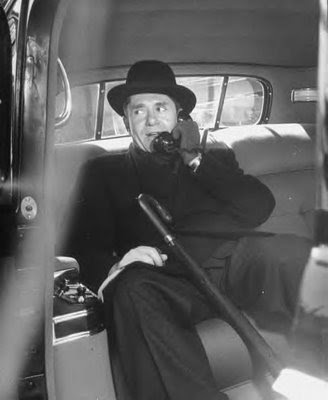
“Not one circus will be left in ten years,” predicted a top-drawer press agent not long after parting company with the Ringling-Barnum show. He was famed Roland Butler, a victim of drastic Ringling rethinking in a new age when the lure of TV advertising favored the ever-experimentally minded John Ringling North (above). ... And that was over fifty years ago (okay, my age can not be denied). Butler’s comments to a friend were mentioned to me, then a kid, in a letter from circus fancier and collectibles dealer Harry (Doc) Chapman, who at the age of 10 could have seen Ringling under canvas in 1893 ... Wandering back today through boyhood correspondence, how favored I was by a steady stream of historically rich letters from Mr. Chapman, who addressed me in any number of ways, one being “P.T. Hammarstrom.” I should will these mighty missives to the Pfennigs of Ohio.
... Some things never change: Back then, old timers talked up the older shows; and now, technically, I’m one, sometimes ruing performances of yesteryear. Back then, JRN turned the circus into a “nightclub” act they said; today, Cirque du Soleil is charged with similar crimes. But the beat of the big top somehow goes on, and it’s still out there on halfway hospitable death trails managing to stay alive. Chapman recalled a time, around 1955 or '56, when Ringling had sold about 675 tickets going into a night show in or around Rochester, NY, and decided to blow the date.
“Full house” or “straw house” are aberrational norms too often expected by yours impatient, who now and then must remind himself that showbiz of all stripes rarely plays to full houses. But, oh, today’s tenacious tenters (all of last season’s contenders are still in biz, as far as I know) seem to be perfecting the art of a fifteen-percent house salvation. In my impetuous youth, I don’t recall empty tents. Gotta tell you, today’s woefully under-attended shows kind of get me down; and they might turn me yet from chronic critic to born-again booster rehabbing to redeem himself in the eyes of the every-protective CFA ... Reading back through my teeth-cutting correspondence, what a pesky know-it-all I was — oops, was? Maybe it was my sheer verbosity that sunk John Swann’s otherwise engaging Circus Review, and caused one reader, Sony Edgar (Henry, was that you?) to tactfully take it to task. I turned out a bloated essay, “How Much Circus Does a Circus Need.” What rhetorical quicksand it was for Swann’s exasperated subscribers; some may have suffocated to death into the third paragraph .. And, still, I ramble on.
Big tops continue to face big hurdles. Now, Big Bertha’s Kenneth Feld finally appears, it would appear, in court to answer charges of animal cruelty and/or domestic insensitivity before, not a jury (how lucky, I’d venture), but before one judge. Trial was said to have kicked off last Wednesday. Considering the money Feld has and the lawyers he can afford, and considering his apparently exemplary track record in handling animals (I am a believer until otherwise convinced), I’d venture to guess that he will walk free; so will those perky pachs ... Said the Big Show’s big man to The New York Times, “I love these animals.”
Circuses reinvent themselves to stay on life support. Now that Big Apple’s founder Paul Binder is officially retired, yet he and new artistic director Guillaume Dufresnoy are off to France shopping for fresh talent. Mr. D. sounds stable and eager. Promisingly, says BAC executive director, Garry Dunning, to the Nashua (New Hampshire) Telegraph: “He has a clear and individual perspective for the company that’s going to be exciting to watch as it grows.” That’s the right start. Tanbark tycoons need full autonomy to find their way.
Out of the Past: Ringling ‘20s aerial icon Tiny Kline in her new book is said to lend a clear impression that Art Concello more or less stole his seat wagon design from Captain Bill Curtis. I’ll hold judgment until I see details. I’ve seen the Curtis wagons, and structurally they bear virtually no resemblance to what Concello invented. Speaking about seat wagon lure, we’ve added a third person to our circle of addicts. Kelly Miller’s own James Royal admits to his own flights of fancy. “Many is the hour I have spent trying to dream up the ultimate seat wagon.” ... Also out of the past and now appearing at the Ringling Circus Museum, formerly known as the John and Mable Ringling Museum of Art, is the majestically restored private car Wisconsin, in which John and Mable sometimes resided during the touring seasons of 1905-1916. The museum’s sugar daddy, Howard C. Tibbals, evidently assisted in this latest installation. BTW: are those Rubens still somewhere on the premises?
Oh, how I’d love to ring up Roland Butler, where he still ringable, and ask how long he thinks today’s big tops will be around ... I'll defer to the still-unsinkable sawdust world. Mr Royal, please, a seat at your wagon.
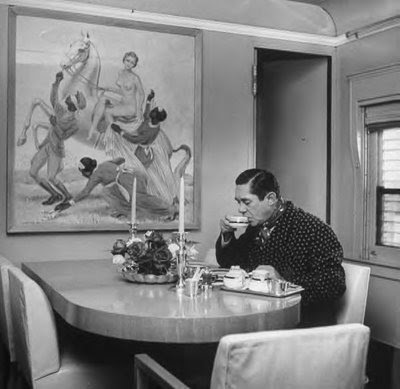
[photos of John Ringling North, 1949, from Circus Anonymous blog. Above, on his private car the Jomar. I couldn't resist; what a work of cinematic art this impresario was]
first posted 2/6/09
Sunday, February 01, 2009
Sunday Morning Scramble: Ringling's Latest, Not the Greatest? The Pope Pets a Tiger; Adult Aussie Midways & Bello's Accidental Hairstack ...
 Down there in Florida, the Felds have failed so far to impress one fan, who got little zing, zang or zoom from a show of the same name. He's Jack Hunter, who rues that the thrill is gone. Says Jack, exclusive to Showbiz David, “It appears to be a long season ahead. I’m still trying to figure out if what I saw was a magic show or illusion, rock show, a little bit of Broadway or some portion of that thing that comes out of Canada” Jack, what you saw was the Feld smorgasbord (likely inspired by CDS’s Believe), maybe this time it’s just a little too smorgy for your taste.
Down there in Florida, the Felds have failed so far to impress one fan, who got little zing, zang or zoom from a show of the same name. He's Jack Hunter, who rues that the thrill is gone. Says Jack, exclusive to Showbiz David, “It appears to be a long season ahead. I’m still trying to figure out if what I saw was a magic show or illusion, rock show, a little bit of Broadway or some portion of that thing that comes out of Canada” Jack, what you saw was the Feld smorgasbord (likely inspired by CDS’s Believe), maybe this time it’s just a little too smorgy for your taste.Now, in all fairness to the Felds at this premature point, I glanced in cyberspace for some reviews; found none. And I’m still intrigued by what the Felds, in their best creative flash —- or creative desperation --- are trying to do to shake the smorgasbord up this way or that ... Heck, John Ringling North is perfect here for a contrasting cameo, for last night on TCM I was struck by how prominent a part his character plays in probably the finest circus film ever made, Trapeze. He is in and out of the circus arena in Paris (what a pleasure to see the acts in a stable ring), until the triple is caught and he’s informing the lucky ones that he'll be taking them to dinner; They by then want nothing more than to appear with Ringling in New York. Paris: you'll have to wait. Remember when the name Ringling was the envy of the circus world?

Papal Petting: The Pope himself was entertained in his gargantuan Roman digs by some jugglers, and also charmed by a baby lion whom he fondly petted ... And while we are here in the tent of divinity, I’m touched by what the Espana family, in Sarasota, have set out to do in their new show called Cirquesa by framing a storyline around the death in 2004 on Ringling of Dessi Espana in a fatal fall. This by way of Covington Connected, in the Sarasota Herald Tribune: “the story enters the dreams of a boy whose mother passes away before fulfilling her promise to take him to the circus.” Okay, you know about me and stories over sawdust, but I’m hoping the family can realize the catharsis and closure it surely deserves. Fabulously fond are my memorizes of the superbly dazzling Flying Espanas with Circus Vargas in the mid-1980s (Ramon, where are you now?) Those passionate show stoppers were Tito Tito terrific!
 All or nothing at all: Seems that the Aussie circus scene might be tainted or — how to put this — “high” on the concession racks. Inside word points to vicious rumors, possibly advanced by envious smaller tenters over the bigger tops, that drugs are being pushed in or around secretive midway spots ... Heck, I have no trouble believing this considering how I have been forced to perceive recklessly creative Circus Oz performers. Even that horny robotic dog they had when they last blitzed Berkeley must be test marketing Viagra for mutes ... And, hey, here’s where we part company (divorce proceedings are in progress): They are neither great circus nor great theatre, but an inventive amalgam in defiance of tradition that sometimes amuses. I am all for their kinky inventiveness, if only they could take their theatrical urges all the way. And if only, pardon my prudery, they would cease and desist from calling themselves a “family show.”.
All or nothing at all: Seems that the Aussie circus scene might be tainted or — how to put this — “high” on the concession racks. Inside word points to vicious rumors, possibly advanced by envious smaller tenters over the bigger tops, that drugs are being pushed in or around secretive midway spots ... Heck, I have no trouble believing this considering how I have been forced to perceive recklessly creative Circus Oz performers. Even that horny robotic dog they had when they last blitzed Berkeley must be test marketing Viagra for mutes ... And, hey, here’s where we part company (divorce proceedings are in progress): They are neither great circus nor great theatre, but an inventive amalgam in defiance of tradition that sometimes amuses. I am all for their kinky inventiveness, if only they could take their theatrical urges all the way. And if only, pardon my prudery, they would cease and desist from calling themselves a “family show.”.All or nothing, part 2: The Nock family have never fully impressed me. When JRN booked their sway pole antics in 1954, “nerveless Nocks” ads promised breath-taking mid-air exchanges, but when I caught up with them the next year, those passing swoops were so cumbersomely careful that the act left me as unthrilled as Jack above. The only thing I really like about their act were the thrilling descents -- each came head first down the tall spars ...
 And then, nocking on, here’s pretty boy "clown" Bello Nock (left), ex-Ringling star of eight years, revealing how he got his signature hair stack. By sheer chance, he claims, following a sunburn at age 11 when, headache induced, he just let his hair grow. Hmmm, is that also how the great Italian jester, Fumagalli, got the same hair style? Or did one of them copy the other?
And then, nocking on, here’s pretty boy "clown" Bello Nock (left), ex-Ringling star of eight years, revealing how he got his signature hair stack. By sheer chance, he claims, following a sunburn at age 11 when, headache induced, he just let his hair grow. Hmmm, is that also how the great Italian jester, Fumagalli, got the same hair style? Or did one of them copy the other?  You’re not going to like me for this: Bello has never struck me as a "greatest clown" in this or any other circus, for the following two reasons. 1. Simply put, the best jesters are subversive outcasts, bullies and blowhards, show offs and losers and misfits who pretend to importance in the spangled shadows. They are us. Bello is too cute, harmless, innocent; 2: with rare exceptions, clowns should not come off as accomplished performers themselves, for this only dilutes their frail common-man persona. Bello is too good an acrobat. In a novel and highly commercial way, I'll admit, his boyish charm tickled moppets who are said to have loved him. If only I could have seen Bello at Polack when I was a boy ...
You’re not going to like me for this: Bello has never struck me as a "greatest clown" in this or any other circus, for the following two reasons. 1. Simply put, the best jesters are subversive outcasts, bullies and blowhards, show offs and losers and misfits who pretend to importance in the spangled shadows. They are us. Bello is too cute, harmless, innocent; 2: with rare exceptions, clowns should not come off as accomplished performers themselves, for this only dilutes their frail common-man persona. Bello is too good an acrobat. In a novel and highly commercial way, I'll admit, his boyish charm tickled moppets who are said to have loved him. If only I could have seen Bello at Polack when I was a boy ...Very sad L.A. Story: Sometimes now, it feels lonely on Sunday mornings without the Los Angeles Times — the one I recall from even five years ago. Now at L’Amyx, I read the NYT, a great paper, but I miss the other one. I’m about the only tea drinker in here with newspaper; others with laptops, maybe a book or two, and school papers. The "city of angels" is a place born, carved out and cut up, glamorized and scandalized by many rapes, and surely the latest one, I’d say, is the rape of the Times by a hack Chicago real estate mogul billions in debt. I love LA, and I miss her once great newspaper that for years, I looked forward to every Sunday ... For all literate Angelinos, I mourn.
All or nothing at all. Next time soon, a Ringling private car is restored; a pachyderm to the circus is born, an ugly lawsuit lingers on. Now if only Mr. Feld could work the birth of a baby bull into his smorgasbord. Jack, how about that?
Hey Sage! Anybody out there on the midway? Two people? NONE? Pack it up and down to the runs. By the way, did Bello return my call yet?

Subscribe to:
Posts (Atom)




